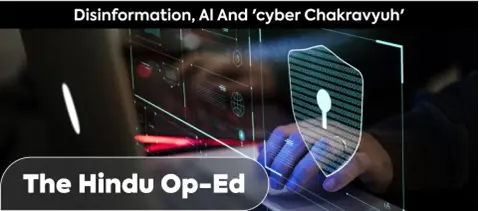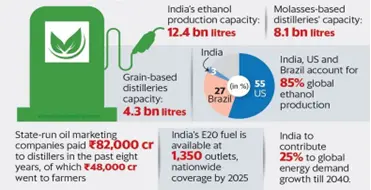Saturday, 17th August 2024
Steps for Implementing Land Reforms in India
Why in the news?
- Recently, the Centre provided states with Rs 10,000 crore in incentives for implementing land-related reforms in rural and urban areas, and Rs 5,000 crore for creating a Farmers’ Registry during the financial year 2024-25 (FY25).
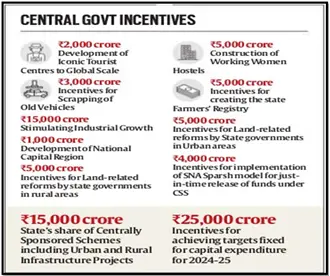
Recent Announcements for Land Reforms Under the Scheme:
- Rural Areas:
- Unique Land Parcel Identification Numbers (ULPIN): ULPIN, also known as Bhu-Aadhaar, will be assigned to land parcels in rural areas.
- Purpose of ULPIN: This unique number will identify every surveyed parcel of land, aiming to prevent land fraud, particularly in rural regions where land records are outdated and often disputed.
- Digitization of Cadastral Maps: Cadastral maps will be digitised, and land subdivisions will be surveyed to reflect current ownership.
- Comprehensive Land Registry: A comprehensive land registry will also be established.
- Urban Areas:
- Financial Incentives: States will receive financial incentives to digitise land records using Geographic Information System (GIS) mapping.
- IT-based Systems: States are required to develop IT-based systems for property record administration, updating, and tax management.
Major Initiatives Undertaken for Land Reforms:
- Pre-Independence Era:
- Land Ownership Structure: During British rule, land ownership was concentrated in the hands of zamindars, jagirdars, and other intermediaries, leaving farmers without direct land ownership.
- Challenges: Key issues included the concentration of land in a few hands, exploitative leasing practices, poorly maintained land records, and fragmented land holdings, which impeded effective land reforms.
- Post-Independence Reforms:
- Committee Recommendations (1949): A committee led by J. C. Kumarappa recommended comprehensive agrarian reforms, including:
- Abolition of Intermediaries: Eliminating intermediaries like zamindars to directly link cultivators with the state.
- Tenancy Reforms: Controlling rent, ensuring tenure security, and granting ownership to tenants.
- Ceilings on Landholdings:
- Introducing Land Ceiling Acts to cap maximum land ownership and prevent concentration.
- Based on Kumarappa's recommendations, ceilings were set to three times the economic holding size required for a family's livelihood.
- By 1961-62, ceiling limits varied by state and were standardised in 1971 with national guidelines ranging from 10 to 54 acres depending on land type and productivity.
- Consolidation of Landholdings:
- Addressing land fragmentation by consolidating small, scattered plots into larger, manageable units.
- Most states enacted consolidation laws, with Punjab and Haryana enforcing compulsory consolidation and other states adopting voluntary consolidation.
- Committee Recommendations (1949): A committee led by J. C. Kumarappa recommended comprehensive agrarian reforms, including:
- Recent Initiatives:
- Digital India Land Record Modernisation Programme (DILRMP):
- Launched in 2008, this program aims to digitise and modernise land records and establish a centralised land record management system.
- SVAMITVA Scheme:
- The Survey of Villages and Mapping with Improvised Technology in Village Areas (SVAMITVA) involves the Ministry of Panchayati Raj, State Panchayati Raj Departments, State Revenue Departments, and the Survey of India.
- To map land parcels in rural areas using drone technology and Continuously Operating Reference Stations (CORS).
- Digital India Land Record Modernisation Programme (DILRMP):
Related Challenges and Steps for Improvement
- Challenges:
- Entrenched Power Structures: Large landowners often resist reforms, obstructing the enforcement of land ceiling acts and redistribution policies.
- Complex Land Records: Outdated and complicated record-keeping systems lead to disputes and hinder land identification for redistribution.
- Land Fragmentation: Land division among heirs results in economically unviable holdings, with average operational holdings decreasing from 2.28 hectares in 1970-71 to 1.08 hectares in 2015-16.
- Legal and Implementation Issues: Weak enforcement of land reform laws and loopholes, such as unclear ceiling limits on a family basis, undermine reform efforts.
- Urbanisation Pressures: Rapid urban development creates challenges in farmland acquisition and farmer displacement.
- Productivity vs. Equity: Balancing land redistribution with effective farming practices is a significant challenge.
- Way Forward:
- Technology Integration: Utilise advanced technologies such as satellite imaging, Artificial Intelligence (AI), and blockchain for digitising and securing land records, enhancing transparency and reducing disputes.
- Legal Framework Enhancement: Strengthen and rigorously enforce land reform laws, address loopholes, and improve implementation mechanisms.
- Learning from Successful Practices: Emulate successful land reform practices from states like West Bengal and Kerala, where reforms have been effective due to strong political will.
- Land Consolidation Initiatives: Promote land consolidation through voluntary pooling and cooperative farming models to enhance agricultural efficiency.
- Equitable Land Acquisition: Develop transparent and fair land acquisition policies with adequate compensation and rehabilitation measures for displaced farmers.
- Support for New Landowners: Provide comprehensive support, including agricultural training, access to credit, and market linkages, to new landowners to improve farming productivity and sustainability.
|
UPSC Civil Services Examination, Previous Year Question (PYQ) Prelims: Q:1 With reference to land reforms in independent India, which one of the following statements is correct? (2019)
Ans: (b)
Mains: Q:1 Establish a relationship between land reforms, agricultural productivity and elimination of poverty in the Indian economy. Discuss the difficulties in designing and implementation of agriculture – friendly land reforms in India. (2013) |
Reshape the Governance Structures of AI Companies
Why in the news?
- Recently, corporations embracing stakeholder capitalism are prioritising products such as Generative AI with focus necessitates governance models that balance profit-making with broader social responsibilities, highlighting a shift in corporate priorities.
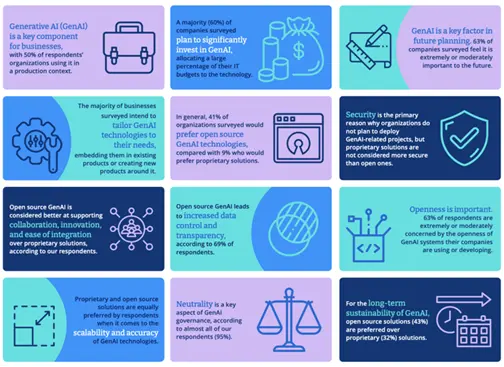
Data Access Issues:
- Dependence on Data: AI advancement requires extensive data, raising privacy concerns due to potential breaches.
- Regulatory Scrutiny: Companies like Meta face challenges over data use for AI, with regulators demanding pauses due to privacy issues.
- Algorithmic Bias: AI systems can perpetuate biases, as seen with Amazon discontinuing a biassed recruiting algorithm.
Purpose vs. Strategy:
- Conflict Between Purpose and Profit: Companies like OpenAI struggle when profit motives conflict with social objectives, exemplified by CEO Sam Altman's dismissal.
- Shareholder Primacy: Despite alternative models, profit pressure often overshadows social benefits.
- Corporate Governance Issues: Internal conflicts in companies like OpenAI question the effectiveness of public benefit structures.
- Potential Shift to For-Profit Models: OpenAI’s potential shift to a for-profit model reflects a trend of prioritising profit over social objectives.
Real-World Examples of AI Bias:
- Meta’s Privacy Issues: Meta faced regulatory scrutiny in Europe, leading to a pause in training large language models with public content from Facebook and Instagram due to privacy concerns from the Irish privacy regulator.
- Amazon’s Recruiting Algorithm: Amazon halted a recruiting algorithm after discovering it exhibited gender bias.
- AI Bias in Language Models: Researchers at Princeton found AI software favouring European names over African American names, highlighting how AI can perpetuate existing biases and create inequality.
Corporate Responses to AI Governance Issues:
- OpenAI and Anthropic's Governance Models: Both companies have adopted governance structures prioritising public good. Anthropic uses a Long-Term Benefit Trust model with financially disinterested members to ensure long-term ethical considerations.
- OpenAI Controversy: OpenAI’s shift to a hybrid model with a capped profit-subsidiary led to controversy, including CEO Sam Altman’s dismissal over commercialization concerns. The incident highlighted the tension between profit motives and public benefit, despite creative governance structures.
What Needs to Be Done: A Workable Strategy
- Enhancing Long-Term Profit Gains: Encourage companies to align public benefit goals with long-term financial returns.
- Incentivizing Managerial Compliance: Reward managers for achieving financial success while adhering to ethical standards, with bonuses tied to ethical performance.
- Reducing Compliance Costs: Simplify processes and offer government incentives, such as tax benefits, to reduce the cost of ethical governance practices.
- Promoting Ethical AI Development: Establish ethical standards for AI governance, similar to the EU’s proposed guidelines for high-risk AI systems.
- Setting Accountability: Ensure transparency, regular audits, diversity in teams, and education in ethics. Consider amendments to corporate governance laws to support these efforts.
| Case Study: In the US, Delaware has set an example by passing a public benefit corporation law that requires companies to consider the public good. This law could serve as a model for encouraging companies to think beyond profit and prioritise societal benefits. |
Implementation Challenges:
- Global Regulation: AI’s global nature complicates regulation due to varying country-specific laws.
- Rapid Technological Advancements: Keeping up with technology’s rapid pace poses a challenge for effective regulation.
- Balancing Regulation and Innovation: Striking a balance is crucial to ensure ethical governance without stifling technological progress.
Conclusion
Reshaping AI governance structures is crucial for aligning AI development with societal values. Integrating ethical considerations into corporate governance is essential for sustainable AI growth and its positive societal impact.
|
UPSC Civil Services Examination PYQ Mains Q:1 The emergence of the Fourth Industrial Revolution (Digital Revolution) has initiated e-Governance as an integral part of government”. Discuss. (2020) |
Source: TH
National Pest Surveillance System (NPSS)
Why in the news?
- Recently, The Centre Govt. has launched the AI-based National Pest Surveillance System (NPSS) to help farmers connect with agriculture scientists and experts for pests’ control.
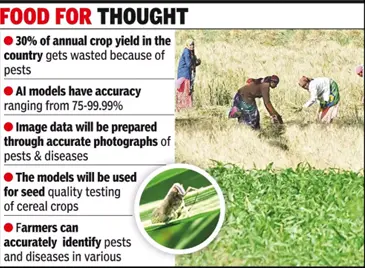
National Pest Surveillance System (NPSS):
- About:
- On August 15, the Indian Government launched the National Pest Surveillance System (NPSS), an AI-driven platform aimed at connecting farmers with agricultural scientists and experts for effective pest management.
- Objectives:
- Reduction of Pesticide Reliance: The NPSS seeks to decrease farmers' dependence on pesticide retailers by promoting a scientific approach to pest control.
- Improved Pest Management: By utilising AI tools, the system aims to enhance the analysis of pest data, thereby facilitating more effective pest control and management.
- Key Features:
- AI Integration: AI tools will analyse pest data to provide actionable insights for pest management.
- Image Sharing: Farmers can capture and send images of infested crops or pests to experts for accurate diagnosis and treatment recommendations.
- Enhanced Connectivity: The platform will connect scientists with approximately 14 crore farmers across India, improving the dissemination of pest management information.
- Timely Information: Farmers will receive prompt updates on pest attacks, which will help in increasing productivity and conserving soil health.
- Implementation: The system will be rolled out at the state level through outreach programs, requiring no additional funding.
- Structure of NPSS:
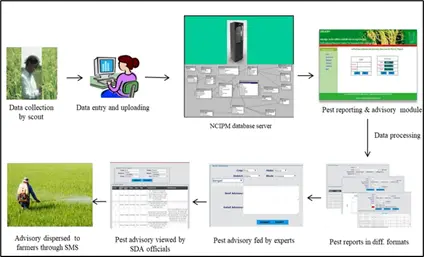
-
- Working of NPSS:
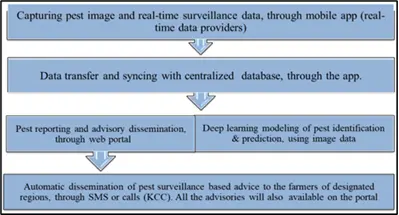
-
-
- System Operation: NPSS operates through an AI-based platform that processes pest-related data, facilitates communication between farmers and experts, and provides timely management advice.
- State-Level Implementation: The system will be integrated into existing agricultural frameworks at the state level to ensure effective outreach and utilisation.
- Proposed Outcomes:
- Pest Surveillance and Management: NPSS aims to create a national system for pest surveillance, offering timely access to expert support for pest identification and management.
- Prevention of Pest Epidemics: The system is designed to prevent pest epidemics and minimise crop loss by enabling real-time data submission and analysis.
- Repository Creation: A national repository of pest scenarios will be established, which will assist public agencies in identifying pest hotspots and formulating effective plant protection policies.
-
|
UPSC Civil services Examination PYQ Prelims Q:1 With reference to Neem tree, consider the following statements:
Which of the statements given above is/are correct?
Answer: C |
Source: TH
Nanjarayan and Kazhuveli Bird Sanctuary & Tawa Reservoir
Why in the news?
- Recently, the Indian government designated Nanjarayan Bird Sanctuary and Kazhuveli Bird Sanctuary in Tamil Nadu and Tawa Reservoir in Madhya Pradesh as new Ramsar Sites.
- This brings India's total number of Ramsar Sites to 85. Tamil Nadu now leads with 18 Ramsar Sites, followed by Uttar Pradesh with 10.
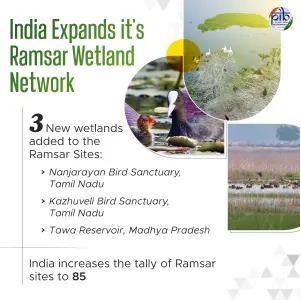
About the Three New Ramsar Sites
- Nanjarayan Bird Sanctuary:
- Location: Northeastern Uthukuli Taluk, Tiruppur District, Tamil Nadu.
- Size: 125.865 hectares.
- Features: Restored by a local king centuries ago; supports agriculture, groundwater recharge, and relies on Nallar drainage rainfall.
- Biodiversity: Hosts species such as Bar-headed Goose, Northern Shoveler, Spot-billed Pelican, and Heronry.
- Management: Designated as Tamil Nadu’s 17th bird sanctuary; managed by the local community and forest department.
- Kazhuveli Bird Sanctuary:
- Location: Coromandel Coast, Villupuram district, north of Pondicherry.
- Size: 5151.6 hectares.
- Features: Large brackish lake connected to the Bay of Bengal via Uppukalli Creek and Edayanthittu Estuary; includes estuarine, creek-fed brackish, and freshwater basins.
- Vegetation: Includes degraded mangrove patches with Avicennia species and extensive reed areas (Typha angustata).
- Tawa Reservoir:
- Location: Confluence of Tawa and Denwa rivers, near Itarsi town, Madhya Pradesh.
- Purpose: Originally built for irrigation; also supports power generation and aquaculture.
- Features: Situated within Satpura Tiger Reserve, bordering Satpura National Park and Bori Wildlife Sanctuary.
- Tributaries: Major tributaries include Malani, Sonbhadra, and Nagdwari. The Tawa River is the longest tributary of the Narmada River.
- Wildlife: Hosts Spotted Deer and Painted Stork.
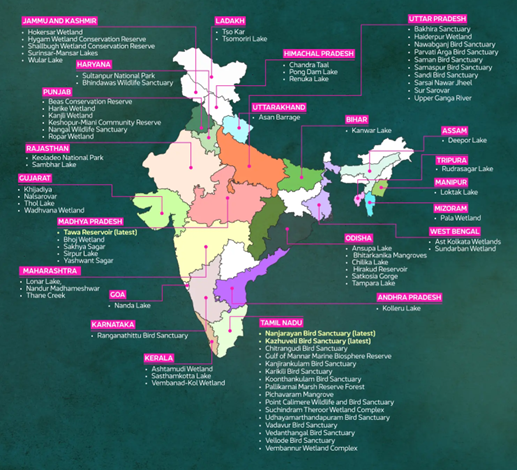
What is the Ramsar Convention?
- About: The Ramsar Convention is an international treaty, signed in 1971 in Ramsar, Iran, under UNESCO, aimed at conserving wetlands of international importance.
- India’s Involvement: The convention came into force in India on February 1, 1982, designating significant wetlands as Ramsar Sites.
- Montreux Record: A register within the Ramsar List for wetlands where ecological changes have occurred or are likely due to human activities or pollution.
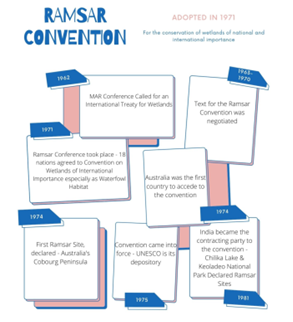
|
UPSC Civil Services Examination, Previous Year Questions (PYQs) Prelims: Q:1 Consider the following statements: (2019)
Which of the statements given above is/are correct?
Ans: (c)
Q:1 With reference to a conservation organisation called ‘Wetlands International’, which of the following statements is/are correct? (2014)
Select the correct answer using the code given below: (a) 1 only (b) 2 only (c) Both 1 and 2 (d) Neither 1 nor 2
Ans: (b)
Mains: Q.:1 What is wetland? Explain the Ramsar concept of ‘wise use’ in the context of wetland conservation. Cite two examples of Ramsar sites from India. (2018) |
India’s Becoming a Global Leader in Semiconductor Production
Why in the news?
- On the 78th Independence Day, the Prime Minister reaffirmed India's ambition to become a global leader in semiconductor production and achieve the target of a Viksit Bharat by 2047.

About:
- Historical Shift: India, once an importer of mobile phones, has developed a robust manufacturing ecosystem, positioning itself as a significant manufacturing hub.
- Investment Appeal: The country is now attracting substantial global investments, with a focus on becoming a leader in semiconductor production.
- State Competitiveness: State governments must implement effective policies to attract these investments, emphasising good governance and law and order.
India’s Semiconductor Industry:
- Market Value: In 2022, the Indian semiconductor market was valued at $26.3 billion, with projections indicating a growth to $271.9 billion by 2032, at a CAGR of 26.3%.
- Components: Semiconductor devices include diodes, transistors, photovoltaic cells, LEDs, and piezo-electric crystals.

Factors Favouring India:
- Skilled Workforce: India excels in STEM education, providing a skilled workforce for semiconductor manufacturing and R&D.
- Cost Advantage: Lower labour costs and an efficient supply chain make India a cost-effective location for semiconductor manufacturing.
- Global Supply Chain Diversification: India is emerging as a key player in back-end assembly and testing, with potential for front-end manufacturing.
- Policy Support: The Indian government has leveraged the global semiconductor supply chain disruption post-pandemic to position India as a viable alternative to China.
Government Initiatives:
- India Semiconductor Mission (ISM): A division within Digital India Corporation aimed at developing a strong semiconductor and display ecosystem.
- Schemes:
- Semiconductor Fab Scheme: Offers 50% fiscal support for the project cost for all technology nodes.
- Display Fab Scheme: Provides 50% fiscal support for the project cost.
- Compound Semiconductor Scheme: Supports 50% of capital expenditure, including discrete semiconductor fabs.
- Recent Approvals: In February 2024, the government approved three semiconductor plants—two in Gujarat and one in Assam.
 Way Ahead:
Way Ahead:
- Exponential Growth: India is set for rapid growth in the semiconductor sector through strategic initiatives and partnerships.
- International Cooperation: MoUs with the European Commission and Japan underscore India’s commitment to enhancing global semiconductor ecosystems.
- Future Outlook: With continued efforts, India aims to become a leading semiconductor manufacturing hub, driving technological progress and economic growth.
Source: PIB
Prerana Programme
Why in the news?
- The Union Minister of Education recently engaged with students, teachers, parents of PM SHRI Schools, and alumni of the Prerana Programmes.

Introduction to Prerana Programme:
- Launch Date: January 2024, initiated by the Union Education Ministry.
- Objective: The program is rooted in integrating the principles of the Indian education system and the philosophy of value-based education, which is a foundational element of the National Education Policy (NEP) 2020.
Key Features:
- Duration and Participants: Prerana is a week-long residential program designed for selected students from classes IX to XII.
- Learning Approach: It offers an experiential and inspirational learning environment for students, utilising cutting-edge technology where heritage and innovation intersect.
- Selection Process: Each week, 20 students (10 boys and 10 girls) from various regions across the country participate in the program.
- Location: The program operates from a Vernacular School established in 1888, located in Vadnagar, Mehsana District, Gujarat.
Curriculum:
- Development: The curriculum, crafted by IIT Gandhinagar, is grounded in nine value-based themes:
- Swabhiman and Vinay
- Shaurya and Sahas
- Parishram and Samarpan
- Karuna and Sewa
- Vividhta and Ekta
- Satyanishtha and Shuchita
- Navachar and Jigyasa
- Shraddha aur Vishwas
- Swatantrata and Kartavya
Purpose:
- The Prerana Programme, centred on these themes, aims to inspire the youth and nurture a deep respect for India's unity in diversity, reflecting the essence of "Vasudhaiva Kutumbakam."
Source: PIB
Gastrodia indica
Why in the news?
- A unique orchid species, Gastrodia indica, has been recently discovered in the Fambonglho Wildlife Sanctuary, Sikkim.

- Introduction to Gastrodia indica:
- Notable Feature: It is the first orchid species from India that never opens its flower.
- Discovery Location: The species was found at an altitude ranging from 1,950 to 2,100 metres above sea level.
- Classification: This marks the first discovery of a cleistogamous species of the genus Gastrodia in India.
- Characteristics of Gastrodia Genus:
- General Traits: The Gastrodia genus is known for terrestrial, herbaceous, and holomycotrophic orchids.
- Reproductive Strategy: Cleistogamous plants, such as Gastrodia indica, are highly specialised, reproducing without relying on external pollinators like insects or wind.
- Nutrition: As a holomycotrophic species, Gastrodia indica depends entirely on a fungal host for sustenance, lacking chlorophyll and deriving carbon from underground fungi.
- Morphological Comparison:
- Relation to Other Species: Although morphologically allied to G. exilis and G. dyeriana, a critical examination has revealed significant differences in floral morphological characteristics.
- Habitat and Ecosystem:
- Environment: This new species thrives in dense, decomposing leaf litter and is associated with tree species such as Magnolia doltsopa, Acer campbellii, and Quercus lamellose.
- Significance and Conservation:
- Contribution to Diversity: The discovery enhances India's botanical diversity, increasing the total number of Gastrodia species in the country to 10.
- Threats: Gastrodia indica faces potential threats due to its limited population and specific habitat requirements.
Source: EM
Practice Questions - Current Affairs 17-08-2024
Q1. Which of the following words have been added to the Preamble by the 42nd Constitutional Amendment Act?
- Socialist
- Unity
- Secular
- Sovereign
Select the correct answer by using the code given below:
(a) 1, 2 and 3 only
(b) 1 and 3 only
(c) 1, 2 and 4 only
(d) 2, 3 and 4 only
Q2. Consider the following statements regarding constitutional amendment acts:
- The 44th Amendment Act of 1978 abolished the right to property as a Fundamental Right only by repealing Article 31 from Part III.
- The 42nd Amendment Act of 1976 added the directive principle, which requires the State to minimize inequalities in income, status, facilities and opportunities.
- 44th amendment act amended Article 356 to specify that the President's rule in the state would only be in effect for six months in the first instance and that it could not last more than one year in most cases.
Which of the statements given above is/are correct?
(a) 1 and 3 only
(b) 1 and 2 only
(c) 3 only
(d) 1,2 and 3 only
Q3. With reference to the views and ideals of liberty, consider the following questions:
- Positive Liberty recognizes inviolable areas of non-interference in which the individual can express himself or herself.
- Negative liberty refers to fewer constraints to the development of the individual personality.
- The focus of Modern liberalism is on individual development.
Which of the above statements is/are not correct?
(a) 1 only
(b) 1 and 2 only
(c) 3 only
(d) 1, 2 and 3
Q4. The Constitution of India provides for a single integrated Judiciary system which means:
- Decisions made by the Supreme court may be binding on the lower courts
- Appellate system exists in India
- A single system of courts enforces both the central as well as state laws.
Which of the given statements is/are correct?
(a) 1 and 2 only
(b) 2 and 3 only
(c) 1 and 3 only
(d) 1,2 and 3 only
Q5. The 42nd Amendment Act of 1976 transferred which subjects to Concurrent List from State List?
- Education
- Population control and family planning
- Forests
- Administration of justice
- Prevention of animal disease
Choose the correct option:
(a) 1, 3 and 4 only
(b) 1, 2, 3, 4 and 5
(c) 2 and 5 only
(d) 1, 2, 3 and 4 only
Q6. According to the Chairman of Drafting Committee of the Constitution, which of the following contains "heart & soul of Constitution"?
(a) Fundamental rights
(b) Directive Principles of State Policy
(c) Preamble
(d) Fundamental Rights and Duties
Q7. With reference to GST Council, consider the following statements:
- It is a constitutional body and was mentioned in the original constitution.
- The Prime Minister is the Chairman of the Council.
- Recommendations of the GST Council are not binding.
Which of the statements given above is/are correct?
(a) 3 only
(b) 1 only
(c) 1 and 3 only
(d) 1, 2 and 3
Q8. With reference to National Emblem, consider the following statements:
- On 26 January 1950, a representation of the Lion Capital of Ashoka placed above the motto, Satyameva Jayate, was adopted as the State Emblem of India.
- The national emblem is adopted from the Lion Capital of Sanchi Stupa.
- Carved out of a single block of polished sandstone, the Capital is crowned by the Wheel of the Law (Dharma Chakra).
Which of the statements given above is/are correct?
(a) 1 and 2 only
(b) 2 and 3 only
(c) 1 and 3 only
(d) 1, 2 and 3
Q9. Which of the following are the federal features of the Indian Constitution?
- Independent judiciary
- Division of powers
- Bicameralism
- Written Constitution
- Two Government
Select the correct answer using the code given below:
(a) 1, 3 and 4 only
(b) 2 and 5 only
(c) 1, 2, 3 and 4 only
(d) 1, 2, 3, 4 and 5
Q10. In the context of India, which one of the following is the characteristic of a finance commission?
(a) An agency with the binding recommendation on the government
(b) An agency having statutory status
(c) An agency that cannot exercise the powers of a Civil Court.
(d) An agency for strengthening the structure of federalism.
Q11. With reference to the Inter-State Council, consider the following statements:
- Parliament is empowered to create an inter-state council at any time.
- Inter-state council is a constitutional body, chaired by the Prime minister.
Which of the statements given above is/are correct?
(a) 1 only
(b) 2 only
(c) Both 1 and 2
(d) Neither 1 nor 2
Q12. Which of the following statements is/are correct regarding Finance commission?
- President of India constitutes the Finance Commission every five years or on time considered necessary by him.
- Parliament determines legally the qualifications of the members of the Commission and their selection methods.
- Finance commission evaluates the rise in the Consolidated Fund of a state in order to affix the resources of the state Panchayats and Municipalities.
Select the correct answer using the code given below:
(a) 1 only
(b) 2 and 3 only
(c) 1 and 3 only
(d) 1, 2 and 3
Q13. Consider the following statements:
- Judicial review is designated only to the higher courts, like the Supreme Court and High Courts.
- The 44th Constitutional Amendment of 1978 had added a Clause to Article 368 placing a Constitutional amendment beyond Judicial review.
Which of the statements given above is/are correct?
(a) 1 only
(b) 2 only
(c) Both 1 and 2
(d) Neither 1 nor 2
Q14. Which of the following Part of the Indian Constitution deals with the Co-operative Societies?
- Part III
- Part IV
- Part XI
- Part IX-A
Select the correct answer using the code given below:
(a) 1 and 2 only
(b) 2, 3 and 4 only
(c) 3 and 4 only
(d) 1, 2 and 3 only
Q15. Consider the following statements:
- Freedom of speech and expression can be suspended only when the National Emergency is declared on the ground of war or external aggression.
- The right to life and personal liberty remain enforceable during the national emergency.
- All fundamental rights except Right to life and personal liberty, operate in case of both External Emergency as well as Internal Emergency.
Which of the statements given above is/are correct?
(a) 1 and 2 only
(b) 2 and 3 only
(c) 2 only
(d) 1, 2 and 3
Q16. Consider the following statements regarding the President Rule?
- Every resolution approving the proclamation of President's Rule can be passed by either House of Parliament only by a simple majority.
- It can be extended for a maximum period of three years.
- Lok Sabha can pass a resolution for its revocation.
Which of the statements given above is/are correct?
(a) 1 and 2 only
(b) 2 and 3 only
(c) 3 only
(d) 1, 2 and 3
Q17. Consider the following subjects:
- Education
- Wild animal and bird protection
- Weights and measures
- Public Health
How many subjects given above is/are comes under the state list of 7th Schedule?
(a) Only 1 Subject
(b) Only 2 Subjects
(c) Only 3 Subjects
(d) All 4 subjects
Q18. Which of the following statements is/are correct about the concept of 'Democracy'?
- Rulers elected by the people take all the major decisions.
- Choice and opportunity to elect rulers are available to all the people on an equal basis.
- It leads to a government limited by the basic rules of the Constitution and citizens' rights.
Select the correct answer using the code given below:
(a) 1, 2 and 3
(b) 1 and 2 only
(c) 2 and 3 only
(d) 3 only
Q19. Which of the following provision of the constitution of India not came into effect on 26 November 1949?
- Elections
- Fundamental Right
- Citizenship
- Provisional Parliament
- Fundamental Duties
Select the correct answer using the code given below:
(a) 1, 3 and 4 only
(b) 2 and 5 only
(c) 3 and 4 only
(d) 5 only
Q20. Consider the following statements:
- Freedom of speech and expression can be suspended only when the National Emergency is declared on the ground of war or external aggression.
- Right to life and personal liberty remain enforceable during the national emergency.
- All fundamental rights except Right to life and personal liberty, operate in case of both External Emergency as well as Internal Emergency.
Which of the statements given above is/are correct?
(a) 1 and 2 only
(b) 2 and 3 only
(c) 2 only
(d) 1, 2 and 3
Share the article
Edukemy’s Current Affairs Quiz is published with multiple choice questions for UPSC exams
MCQ
Get Latest Updates on Offers, Event dates, and free Mentorship sessions.

Get in touch with our Expert Academic Counsellors 👋
FAQs
UPSC Daily Current Affairs focuses on learning current events on a daily basis. An aspirant needs to study regular and updated information about current events, news, and relevant topics that are important for UPSC aspirants. It covers national and international affairs, government policies, socio-economic issues, science and technology advancements, and more.
UPSC Daily Current Affairs provides aspirants with a concise and comprehensive overview of the latest happenings and developments across various fields. It helps aspirants stay updated with current affairs and provides them with valuable insights and analysis, which are essential for answering questions in the UPSC examinations. It enhances their knowledge, analytical skills, and ability to connect current affairs with the UPSC syllabus.
UPSC Daily Current Affairs covers a wide range of topics, including politics, economics, science and technology, environment, social issues, governance, international relations, and more. It offers news summaries, in-depth analyses, editorials, opinion pieces, and relevant study materials. It also provides practice questions and quizzes to help aspirants test their understanding of current affairs.
Edukemy's UPSC Daily Current Affairs can be accessed through:
- UPSC Daily Current Affairs can be accessed through Current Affairs tab at the top of the Main Page of Edukemy.
- Edukemy Mobile app: The Daily Current Affairs can also be access through Edukemy Mobile App.
- Social media: Follow Edukemy’s official social media accounts or pages that provide UPSC Daily Current Affairs updates, including Facebook, Twitter, or Telegram channels.


